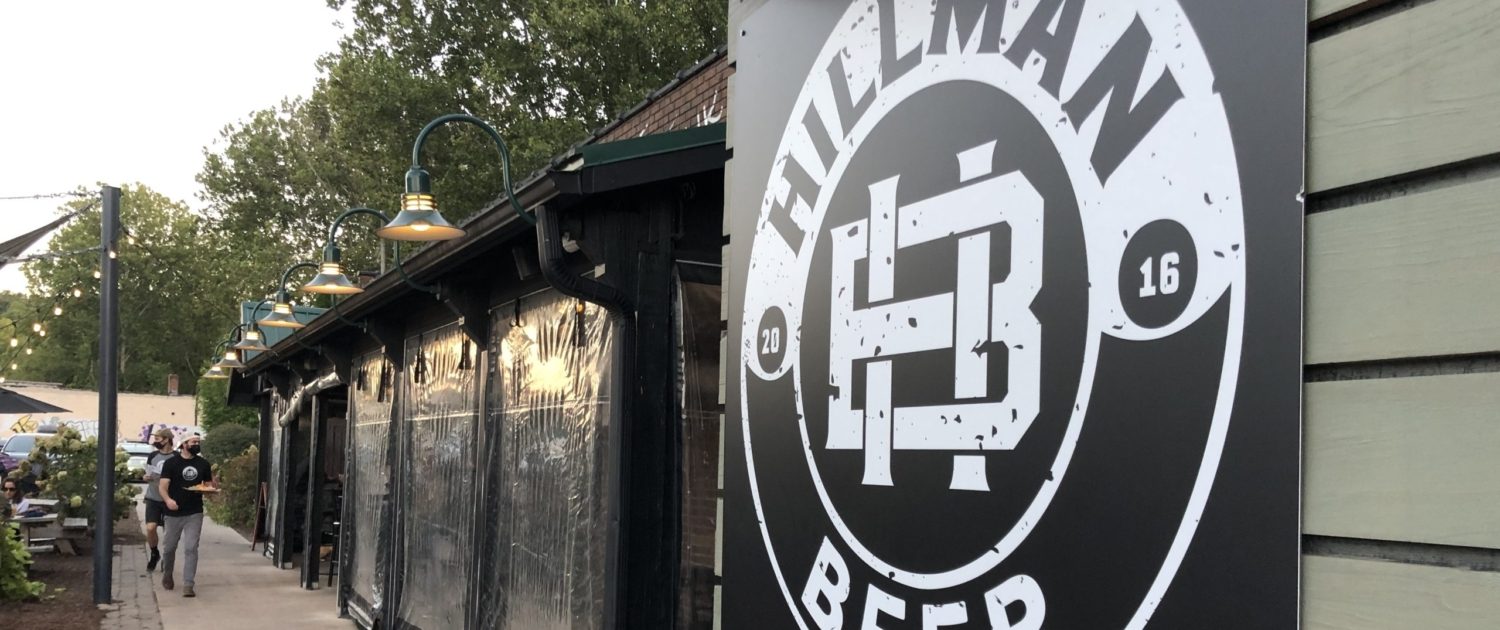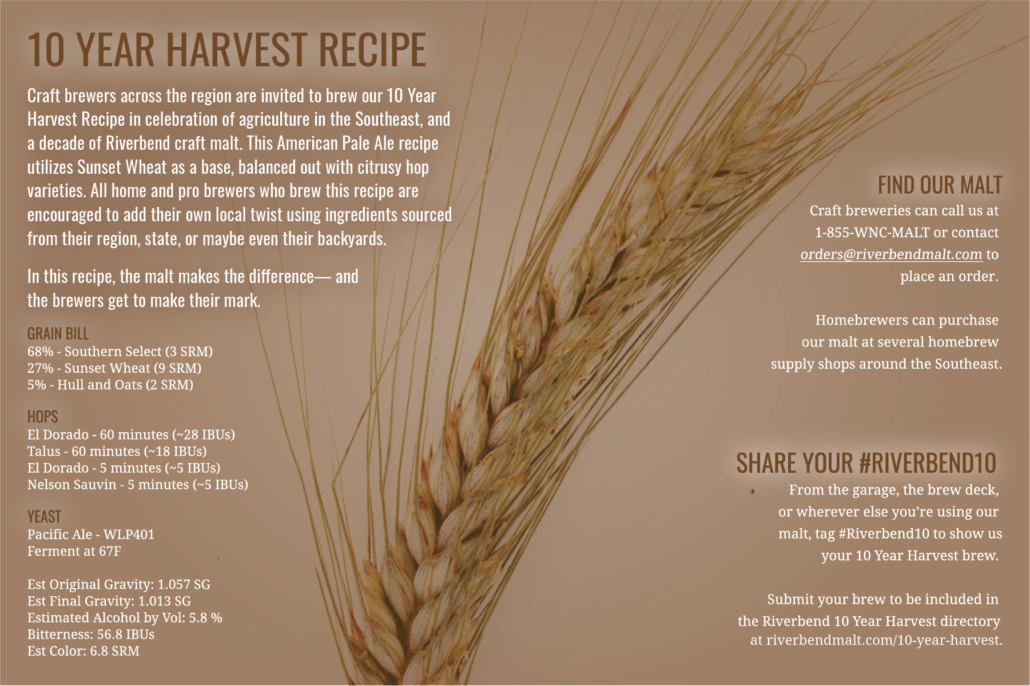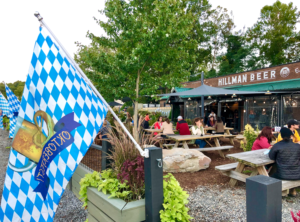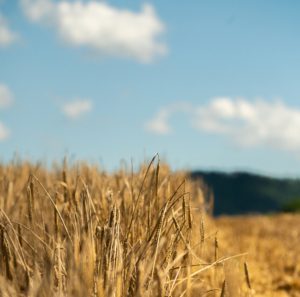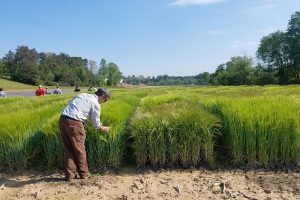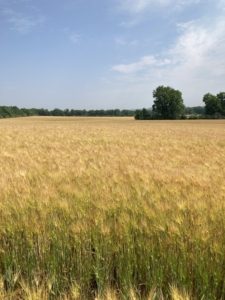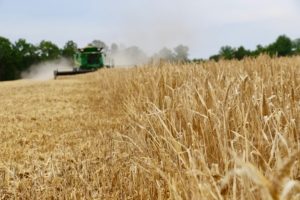Riverbend turns 10 and creates their anniversary Sunset Wheat. Find details here.
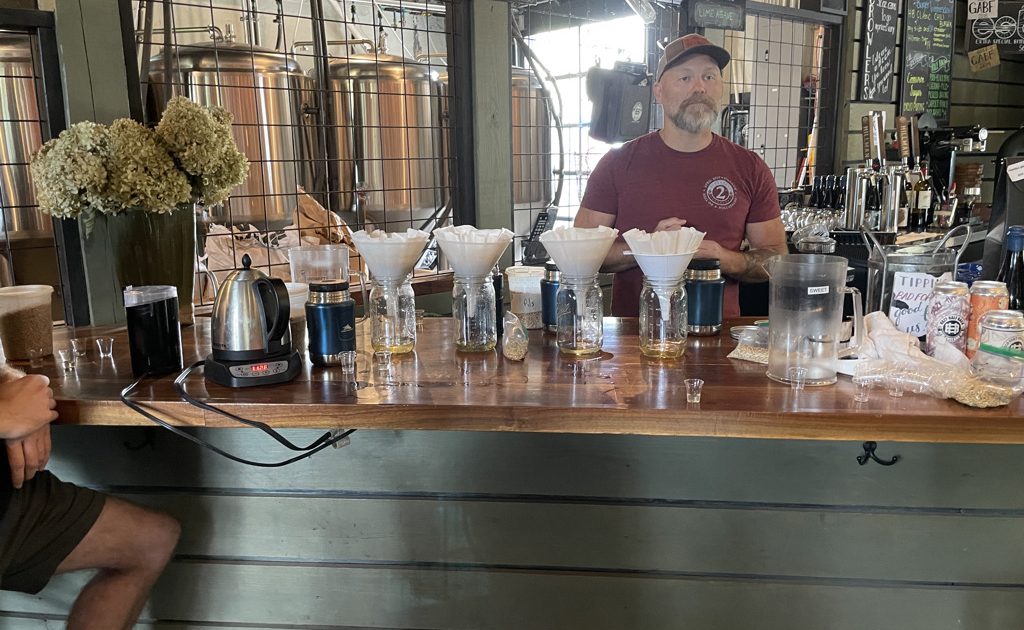
Hillman Beer Company
If we had a nickel for every conversation we had with small batch producers about why craft malt is the sustainable, marketable choice for ingredient purchasing… well let’s just say we’d have a lot of nickels.
Enter a hot steep demonstration that we’ve fondly coined the “craft malt pepsi challenge” in which we compare the flavor profile of Riverbend malt to that of larger commodity brands. The contrast is stark.
A couple weeks back, we engaged in this hot steep juxtaposition with long-time Riverbend customer Hillman Beer Company who we’re pleased to report just made the switch to Riverbend as its primary base malt provider. Hillman has always had around 15 percent of the beers on their board made with our malts, and it’s an honor to say that number has jumped to around 85 percent.
“We love having Riverbend as neighbors,” says Co-Founder Brad Hillman. “We love that we can say all the malt is grown within 500 miles from Asheville. For customers, it’s cool to know that your beer is grown locally. It’s also cool to know you’re supporting local farmers. There are so many different things to be proud of here.”
In April of this year, Hillman joined the Craft Malt Certified™ seal, a pledge to purchase ten percent or more craft malt as part of total annual malt purchases. That was a no-brainer for Hillman, who is already using Riverbend’s Chesapeake Pilsner for their Kölsch and Old Fort Original Lager, and pretty much any other beer that requires Pilsner malt,” Brad adds. He uses Riverbend’s Southern Select as a “nice in-between base malt between Pilsner and Marris Otter,” and Streaker Oats make their appearance in many of Hillman’s Belgian-inspired and sour beers.
Next up for Hillman is an Amber Rye Lager made with Riverbend’s Carolina Rye malt and Munich Rye malt varieties, releasing in mid-December.
“The proof’s in the beer,” Brad says. “Their malt is just great.”
Craft brewers across the region are invited to brew the Riverbend Malt House 10 Year Harvest Recipe in celebration of agriculture in the Southeast and a decade of Riverbend craft malt.
The #Riverbend10 Wheat Pale Ale recipe utilizes the Riverbend anniversary Sunset Wheat as a base, balanced out with citrusy hop varieties. In this recipe, the malt makes the difference— and the brewers get to make their mark. By design, this pale ale is a clean, malt-forward canvas for showcasing local agriculture. All home and pro brewers who brew this recipe are encouraged to add their own local twist using ingredients sourced from their region, state, or maybe even their backyards.
Find our malt at these homebrew supply shops.
Tag #Riverbend10 to show us your 10 Year Harvest brew!
Submit your recipe to our anniversary beer log here.
It’s official! American Single Malt Whiskey will become a new category for spirits across the United States in early 2022. The American Single Malt Whiskey Commission has been hard at work for years now to make this happen. We tip our hats to them.
The category will be defined by the following criteria….
- made from 100% malted barley
- distilled entirely at one distillery
- mashed, distilled and matured in the United States of America
- matured in oak casks of a capacity not exceeding 700 liters
- distilled to no more than 160 (U.S.) proof (80% ABV)
- bottled at 80 (U.S.) proof or more (40% ABV)
As you can probably imagine, we are excited about this new development. It offers an excellent opportunity to explore the world of craft malt flavor in a distilled format… the intersection of art science for both maltster and distiller!
Most Scotch Whisky is produced using a Pale Ale style malt (think Maris Otter) that can be kilned with or without the introduction of peat smoke. In this case the maltster is delivering a nicely balanced package of rich, bready flavors along with sufficient enzymes to support efficient conversion. These malts combined with pot still based production runs yield a spirit with substantial mouthfeel and complexity.
But what happens when we explore different varieties of barley or higher kilned specialty malts within these same production techniques? What happens when we utilize column or hybrid stills? What happens when we experiment with different proof levels coming off of the still?
To quote my friend Jason Parker from Copperworks Distilling Company… ”We get to write the book”!
Craft maltsters across the United States work with numerous 2-row and 6-row varieties of both Winter and Spring barleys to create a wide range of flavorful base malts that will support this new style. Our experience with Southern-grown winter barley has demonstrated distinctive and consistent differences in varieties that range from biscuits and hearth-baked bread to floral and melon notes. These nuances will undoubtedly have a positive impact on the finished spirit.
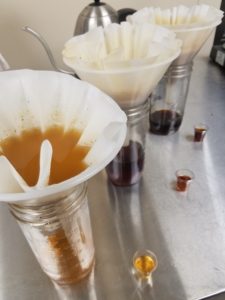
Riverbend’s Munich “family”…Vienna, Light Munich, and Dark Munich
Incorporating Munich-style malts into the grain bill will also set the table for an exciting departure from the norm. More sweet aromatics like honey, vanilla, and cake batter will now be present and available to contribute flavors to distillate that haven’t been thoroughly explored. Couple this with variations in climate that impact the aging process and you have the building blocks of terroir for American Single Malt.
While not technically keeping with the new definition of the style, the classic rye versus wheat debate in bourbon could also spur additional avenues for innovation for American Malt Whiskey. Gently kilned soft white wheats might introduce delicate floral notes similar to fine pastries. Heirloom and modern rye varieties could contribute rich, earthy spice reminiscent of pumpernickel bread.
Last, but not least, we have smoke. Native hardwoods, fruit woods, and decommissioned barrels could all play a role in building unique character. Several of our customers have already begun to experiment in this space and we are waiting patiently for the first releases to be bottled!
Got an idea for a unique grain bill? Want to discuss a custom malt project for your distillery? Give us a shout. We look forward to exploring this new chapter in artisan spirits together!
From pumpkin ales to Oktoberfest biers — fall is in the beer.
Asheville’s Riverbend Malt House is a key component in producing these autumnal flavors, which won’t last long on tap across the Southeast this season. Don’t miss these fall beers made with Riverbend craft malt.
Hillman Beer
Hillman Festbier is brewed with a combination of Riverbend Malt’s Chesapeake Pilsner, Vienna, and Light Munich malts. The result: a light, crisp, and complex beer perfect for sipping at the start of fall.
Swells’a Brewing
Swellsa’s new Oktoberfest Märzen, Oct-toobs Fest, is made with 100% North Carolina malts from Riverbend Malthouse and is a quintessential Bavarian lager. A full amber body with balanced sweetness and a dry finish make this lager highly drinkable, and delicious.
DSSOLVR
Hey Hey Yah Yah is DSSOLVR’s inaugural Festbier. Mashed with 100% Riverbend Malt grist, it’s composed of a blend of Chesapeake Pilsner, Light Munich, Vienna, and Chit malts hopped with Hallertauer Mittelfruh. It’s fermented low and slow with DISSOLVR’s house lager yeast, and finally sounded for natural carbonation.
Oklawaha Brewing
Meet Oklawah’s first-ever Festbier! Featuring Riverbend Malt’s Cumberland Pilsner, Vienna Malt, and Biscuit Malt, this beer is a glass full of sunshine to wind down summer. Crushable and light with a sweet biscuit-y, it’s a perfect early fall brew.
Crooked Can Brewing Company
Using a small, handcrafted batch of Florida grown rye malt from Riverbend Malt House, Flo-Rye-Da Pumpkin Ale is a true celebration of the season. Warmed bread and baked spice flavors from the rye pair perfectly with the 100 pounds of all-natural pumpkin puree in the mash. Added hints of cinnamon and nutmeg round out a sweet spiciness that makes this beer an autumn obsession.
Printshop Beer Co. & Next Level Brewing Knoxville
This killer Oktoberfest Marzen collab is the lovechild of two beloved Knoxville breweries. Bruno Marzen is crafted with Riverbend’s Base Camp and Great Chit malts, with a dash of both light and dark Munich Rye for a little spice. Crisp and addictively delicious, this Marzen is a great way to celebrate the season. Prost!
What Riverbend craft malt are you sipping this season? Show us your beers with #madewithRiverbend on social!
After 10 years in the craft malt business, we’re reflecting on our past, and how we want to approach our future with the least environmental impact possible. The timing was perfect for Medium.com’s Authority Magazine to interview us about our sustainability mission.
Congratulations are in order to so many of our brewery customers for cleaning up at this season’s awards— including the Great American Beer Festival®, the U.S. Beer Open, the North Carolina Brewers Cup, and the National Honey Board Honey Beer Competition to boot. Thanks to these companies for their support of craft malt, and props to them for transforming our ingredients into world-class beers.
Photo © Brewers Association
Here’s a non-exhaustive list of some of the beer competition winners. Congratulations to all!
TransAmLam – Bronze, Great American Beer Festival Belgian-Style Sour Ale
Wicked Weed Brewing in Asheville, North Carolina
Old City Tract – Gold, U.S. Beer Open Munchner Dunkel / Dark
Perfect Plain Brewing in Pensacola, Florida
Ardorbier – Silver, U.S. Beer Open Vienna
Perfect Plain Brewing in Pensacola, Florida
The Pulse has the skinny on Perfect Plain’s award-winners here.
Low Poly – 2nd Place, North Carolina Brewers Cup International Pils
Bhramari Brewing in Asheville, North Carolina
Arcane Priestess – 1st Place, North Carolina Brewers Cup European Sour Ale
(Best of Show runner up, too!)
Bhramari Brewing in Asheville, North Carolina
Set It On Fire – 2nd Place, North Carolina Brewers Cup Smoke Beer
Bhramari Brewing in Asheville, North Carolina
Bone Apple Teeth – 1st Place North Carolina Brewers Cup Brett, Mixed & Wild Ale
DSSOLVR Brewing in Asheville, North Carolina
Braggot – Gold, National Honey Board Honey Beer Competition Braggot
Carolina Bauernhaus Brewery & Winery in Anderson, South Carolina
We’re inspired by the eco-conscious and passionate crafters of small batch beer and spirits in the Southeast, and we’re on a mission to create a local, sustainable food system that adds value and credibility to these artisan products that tell the story of our region. Here are six reasons to use our craft malt in your next recipe.
Family Farms First: When you make Riverbend Malt your malt supplier, you’re supporting Southeast family farms such as Walnut Grove, ASR Grain, Bay’s Best, and Teeter Farm. Supporting local farmers helps create a complete ecosystem for local beer and artisan spirits.
Transparency & Traceability: We’ll tell you how some of the best malt in North America is sourced, down to the farmer and field. Our goal is to purchase 100% of our raw materials from within a 500-mile radius of the malt house. We currently partner with family farmers in North Carolina, Georgia, Kentucky, South Carolina, Tennessee and Virginia. The majority of our 2021 harvest was sourced from North Carolina, which meets our ongoing objective to shorten our supply chain.
Quality & Freshness: Great malt requires great grain, so we pay premium prices to ensure we have access to the best raw material available. We use the highest quality heirloom and newly released grains and traditional floor-malting techniques; each batch undergoes thorough testing including a sensory evaluation and third party analysis. And, you’ll get it fresh.Our malt doesn’t have to cross the ocean in a bulk bin— and our brewery and distillery partners can taste the difference.
Service With a Smile: : We’re on a mission to help you grow your business. Let’s put our heads together— our craft maltsters are here to help you with process issues or other challenges that come up in your brewhouses and distilleries.
We like to be good neighbors, too: if you’re in the Asheville area, your delivery is on us! No matter where you are, our short supply chain and easy ordering process allow for faster delivery.
Malt On A Mission: Making great craft malt isn’t possible without healthy people and a healthy planet. We’ve been Living Wage Certified since 2014, and we’ve paid 100 percent of employee healthcare insurance premiums since 2018.
The grains that commodity malting operations use have a long ride from farm to malthouse, often 2,000 miles or more. The less distance grains have to travel from farm to malthouse, the less carbon emissions that are produced. We’ve reduced 1,064,030 pounds of CO2 by purchasing from family farms located within 500 miles of our malthouse. And, most are actually within 300 miles.
Storytelling: Utilizing craft malt isn’t just a purchasing decision, it’s also a brand position that differentiates and adds value to your final products. Breweries and distilleries choosing to invest in their sourcing amplify the voice of the craft malt narrative buzzing in communities across the country.
Long story short, we’re proud of our malt and our people, and deeply committed to our mission. We’re ready to talk shop any time. Send us your questions at orders@riverbendmalt.com.
Excited to share the news of a bountiful harvest! Back in June we collected grain samples from around our region and patiently waited for the lab results. The early reports were strong, showing solid protein levels, strong germination, and little evidence of pre-harvest sprout.
After reviewing these data, we’ll be bringing in a majority of our grain from North Carolina….which is always the goal we strive for! Tennessee, Virginia, and Kentucky growers will supply the remaining portion. We’ll also have Georgia-grown wheat and some Florida grown rye available, too! We decided to have a little fun with the name on that one…..calling it Flo-Rye-da.
We applaud all of the hard work that goes into growing a beautiful crop of barley. Our growers are definitely “students of the game”, always looking to fine tune their approach. It could be as simple as switching to a field with slightly better drainage, or something more technical like updating their pest management strategy. Their efforts and increasing experience levels are beginning to pay dividends. When grain yields in the Southeast begin to rival those of the traditional barley growing regions out West (>100 bushels/acre), you know they are doing something right!
Seeing these bright, plump kernels and hearing about increasing yields illustrate how much has been achieved across our supply chain. Early on, we were probably a bit of nuisance to our growers…..asking for small amounts of specific varieties with strict quality parameters. Ten years later, we are receiving truckloads of grain every few days. These volumes provide meaningful income and support jobs at each link in the chain. Portions of these purchases also support the research that will bring us the next round of 2-row varieties.
Couple all this good news with the rise of some stellar craft lagers and single malts that are being created from these grains and you have a distinctive a host of beverages that showcase a terrior that is unique to Southeast!
- Brent
Wow, the samples are starting to arrive and they look beautiful!
Each year we hold our collective breathe from late May to mid June, watching the weather and waiting for early reports on grain quality. These crucial weeks determine the next 15 months for us. If heavy rains fall and the crop suffers, we have a long road ahead. If the skies clear, we can match quality specs with just about anyone.
Many of you may have heard me mention the “Father’s Day” rains that can make or break our harvest. Over the past few years a lingering storm system has often developed and remained stagnant over some of our grower’s fields. This prolonged mix of precipitation and heavy cloud cover can lead to pre-harvest sprout damage, weathered kernels, and low test weight.
I’m happy to report that our early June rains were brief and followed by abundant sunshine….the perfect recipe for a solid harvest!
Bright kernels, high test weight, low DON levels and recording breaking yields.
Over the next few weeks, our production team will pour over the incoming data and make our selections for the coming year. We should have abundant, high-quality 2-row from growers throughout the Southeast. Stay tuned for a few surprises as well!
- Brent
Let’s brew up something good.
Talk to our expert maltsters about the best malt for your project or work with us to create a custom malt.

